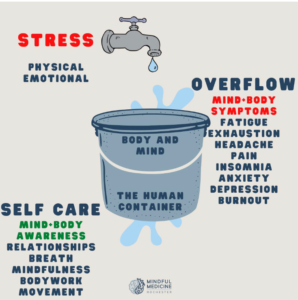People most often associate chronic pain with backaches, sore knees, or stiff necks. But many persistent symptoms don’t fall into those “basic” categories. Examples include migraines, rashes, swelling, and irritable bowel syndrome. These symptoms often involve physiological changes in the body – and that can make it harder to believe that Pain Reprocessing Therapy (PRT), a brain-focused intervention, could help.
Interestingly, these less “basic” categories of symptoms may actually demonstrate the clearest examples of the mind-body connection in action. In such cases, the body’s threshold for responding to stress or danger cues is often set unusually low. The nervous system generates a physical reaction – like inflammation, swelling, or pain – more quickly than it should. So rather than focusing directly on the symptom or applying somatic tracking while it’s active, the work begins before the symptom is triggered.
“Almost everything will work again if you unplug it for a few minutes, including you. ~ Anne Lamott
How Much Is Too Much
The key is recognizing the buildup of stress, fear, or dysregulation early, and helping the brain return to a place of safety before reaching a point of overwhelm.
At a base level, anything that makes us feel threatened can contribute to pain and other unwanted symptoms, and anything that helps us feel safe can reduce these symptoms. We all have a “stress threshold”. Our threshold moves based on how safe we feel – when feeling threatened, this threshold is lower.
The best analogy we can think of is how you might attend to a leaky ceiling in your home. You might place a bucket beneath the leak to catch the water. If you occasionally check on the bucket and empty it out before it overflows, you will never have a messy puddle of water on the floor. But, if you neglect the bucket, it is bound to overflow and leave a mess. The same concept applies to stress in our lives. We all have stress (the water leaking), and each of us have varying sized capacities (buckets) to handle the stress. Some of us can hold a lot before feeling overwhelmed, and some of us can hold a bit less. In fact, our own bucket sizes may vary day-to-day.
But, if you attend to yourself and pour out some of the stress throughout your day, you won’t reach your maximum threshold or point of overflow which may trigger a panic/anxiety attack, pain/amplified pain, or uncomfortable and unpleasant symptoms like IBS, migraines, swelling, hives, rashes, etc.
Below is a picture we like to share with our patients to demonstrate this idea:

Emptying the bucket might look like:
– Pausing and checking in with yourself throughout the day.
– Learning what nervous system “yellow lights” feel like before they become “red”.
– Reducing high-alert behaviors like doom-scrolling, excessive news consumption, or constant rushing.
– Practicing nervous system regulation skills like mindfulness and breathing exercises even when symptoms aren’t flaring.
– Developing a deeper sense of self-awareness and subsequently getting better at giving yourself what you need.
– Reaching out to others for connection, nurturance, and assistance when needed.
– Prioritizing sleep and nutrition.
– Learning to say no.
– Doing things you enjoy.
Over time, this work helps raise the threshold at which symptoms are triggered, and that can make life feel more stable, balanced, and within your control.
Reading
The Organized Mind: Thinking Straight in the Age of Information Overload by Daniel J. Levitin
Levitin, a neuroscientist focused on the intersection of technology, addiction, and productivity, discusses the serious physiological effects of cognitive overload. Brain overwhelm and overstimulation increases the production of the stress hormone cortisol, as well as the fight-or-flight hormone adrenaline. As you may know, these hormones signal danger to your brain, likely causing symptoms to erupt.
Preoccupying, multitasking, and constant decision-making can overstimulate the brain and cause mental fog, scrambled thinking, worry and anxiety. The Organized Mind uses the latest brain science to offer readers methods to regain a sense of mastery and control over their time and their lives, applying the cognitive neuroscience of attention and memory to enhance productivity without simultaneously punishing the body and brain.